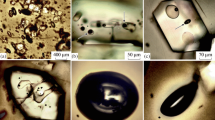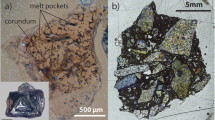Abstract
At present the best estimates of the oxygen fugacity of spinel-lherzolites that could be the source material of basic magmas is about five log units below the Ni−NiO buffer to one above it. However partially glassy basic lavas, ranging from MORBs to minettes, all with olivine on their liquidus, cover a wider range, and may have oxygen fugacities that extend to four log units above NNO. Surprisingly the range of oxygen fugacities observed in silicic lavas and ashflows with quartz phenocrysts is smaller, despite a crustal dominated evolution. The peralkaline silicic lava type pantellerite is the most reduced, equivalent to MORBs, whereas the large volume ashflows with phenocrysts of hornblende and/or sphene are the most oxidised. As the concentration of water in the basic lavas is correlated with increase in their redox state, it would seem that water could be the agent of this increase. That this is unlikely is seen in the behavior of silicic ashflows and lavas, particularly those of Yellowstone. Here the silicic magmas of the last 2Ma contain about 2 wt% FeO(total), and typically phenocrysts of fayalite, quartz and Fe−Ti oxides. Despite extensive exchange of the 18O of the magma with meteoric water after caldera collapse (Hildreth et al. 1984), there is no displacement of the redox equilibria. Thus the thermal dissociation of molecular H2O to H2, and its subsequent diffusive loss to cause oxidation must have been minimal. This could only be so if the activity of water was small, as it would be if H2O reacted with the silicate liquid to form OH groups (Stolper 1982). The conclusion is that silicic magmas with small amounts of iron and large amounts of water do not have their redox states reset, which in turn presumably reflect their generation. By analogy basic magmas with large amounts of iron and far less water are even less likely to have their redox equilibria disturbed, so that their oxygen fugacities will also reflect their source regions. The effect of pressure on the ferric-ferrous equilibrium in basic magmas can be calculated from experimental measurements of the partial molar volumes of FeO and Fe2O3, and their pressure derivatives ϖV/ϖP, in silicate liquids. The effect of pressure is found to be about the same on the liquid as it is for various solid oxygen buffers. Accordingly there should be mantle source regions covering the same range of oxygen fugacity as that found in basic lavas, but so far samples of spinel-lherzolite of equivalent oxygen fugacity to minettes or other potassic lavas have not been found. Whether or not the redox state of phlogopite-pyroxenites is equivalent to these potassic lavas cannot be established without experiment.
Similar content being viewed by others
References
Anderson AT (1974) Chlorine, sulfur and water in magmas and oceans. Bull Geol Soc Am 85:1485–1492
Anderson AT, Wright TL (1972) Phenocrysts and glass inclusions and their bearing on oxidation and mixing of basaltic magmas, Kilauea volcano, Hawaii. Am Mineral 57:188–216
Arculus RJ, Delmano JW (1981) Intrinsic oxygen fugacity measurements: techniques and results for spinels from upper mantle peridotites and megacryst assemblages. Geochim Cosmochim Acta 45:899–913
Arculus RJ, Dawson JB, Mitchell RH, Gust DA, Holmes RD (1984) Oxidation states of the upper mantle recorded by megacryst ilmenite in kimberlite and type A and B spinel lherzolites. Contrib Minral Petrol 85:85–94
Bacon CR, Adami LH, Lanphere MA (1989) Direct evidence for the origin of low 18O silicic magmas: quenched samples of a magma chamber's partially-fused granitoid walls, Crater Lake, Oregon. Earth Planet Sci Lett 96:199–208
Berman RG (1988) Internally consistent thermodynamic data for minerals in the system Na2O−K2O−CaO−MgO−FeO−Fe2O3−Al2O3−SiO2−TiO2−H2O−CO2. J Petrol 29:445–522
Bryndzia LT, Wood BJ, Dick HJB (1989) The oxidation stae of the Earth's sub-oceanic mantle from oxygen thermobarometry of abyssal spinel peridotities. Nature 341:526–527
Buddington AF, Lindsley DH (1964) Iron-titanium oxide minerals and synthetic equivalents. J Petrol 5:310–357
Carmichael ISE (1967) The iron-titanium oxides of salic volcanic rocks and their associated ferromagnesian silicates. Contrib Mineral Petrol 14:36–64
Carmichael ISE, Turner FJ, Verhoogen J (1974) Igneous petrology. McGraw-Hill, New York, p 739
Carmichael ISE, Ghiorso MS (1986) Oxidation-reduction relations in basic magma: a case for homogeneous equilibrial. Earth Planet Sci Lett 78:200–210
Carmichael ISE, Lange RA, Luhr JF (1991) The minettes and associated lavas of the Mascota region, western Mexico (in preparation)
Chiba, N, Chacko RN, Clayton RN, Goldsmith JR (1989) Oxygen isotope fractionations involving diopside, forsterite, magnetite and calcite: Application to geothermometry. Geochim Cosmochim Acta 53:2985–2995
Christie DM, Carmichael ISE, Langmuir CH (1986) Oxidation states of mid-ocean ridge basalt glasses. Earth Planet Sci Lett 79:397–411
Dixon JE, Stolper E, Delaney JR (1988) Infrared spectroscopic measurements of CO2 and H2O in Juan de Fuca Ridge basaltic glasses. Earth Planet Sci Lett 90:87–104
Ewart AE, Green DC, Carmichael ISE, Brown FH (1971) Voluminous low-temperature rhyolitic mamas in New Zealand. Contrib Mineral Petrol 33:128–144
Ewart AE, Hildreth EW, Carmichael ISE (1975) Quaternary acid magma in New Zealand. Contrib Mineral Petrol 51:1–27
Fudali RF (1965) Oxygen fugacities of basaltic and andesitic magmas. Geochim Cosmochim Acta 29:1063–1075
Gerlach TM (1980) Evaluation of volcanic gas analyses from Kilauea volcano. J Volcanol Geotherm Res 7:295–317
Ghiorso MS, Carmichael ISE (1985) Chemical mass transfer in magmatic processes. II Applications in equilibrium crystallization, fractionation and assimilation. Contrib Mineral Petrol 90:121–141
Ghiorso MS, Sack RO (1991) Fe−Ti oxide geothermometry: thermodynamic formulation and the estimation of intensive variables in silicic magmas. Contrib Mineral Petrol (in press)
Hasenaka T, Carmichael ISE (1987) The cinder cones of Michoacan-Guanajuato, Central Mexico: petrology and chemistry. J Petrol 28:241–269
Hildreth W (1979) The Bishop Tuff: evidence for the origin of compositional zonation in a silicic magma chamber. Spec Pap Geol Soc Am 180:43–75
Hildreth W, Christiansen RL, O'Neil JR (1984) Catastrophic isotopic modification of rhyolitic magma at times of caldera subsidence, Yellowstone Plateau volcanic field. J Geophys Res 89:8339–8369
Huebner JS, Sato M (1970) The oxygen fugacity-temperature relationships of manganese oxide and nickel oxide buffers. Am Mineral 55:934–952
Katsura T, Nagashima S (1974) Solubility of sulphur in some magmas at I atmosphere. Geochim Cosmochim Acta 38:517–532
Kilinc A, Carmichael ISE, Rivers ML, Sack RO (1983) Ferric-ferrous ratio of natural silicate liquids equilibrated in air. Contrib Mineral Petrol 83:136–140
Kress VC, Carmichael ISE (1988) Stoichiometry of the iron oxidation reaction in silicate melts. Am Mineral 73:1267–1274
Kress VC, Carmichael ISE (1989) The lime-iron-silicate melt system: Redox and volume systematics. Geochim Cosmochim Acta 53:2883–2892
Kress VC, Carmichael ISE (1990) The iron redox state in silicate liquids: the effect of pressure, temperature, oxygen fugacity and composition, with application to the genesis of basic magma. Contrib Mineral Petrol (submitted)
Kyser TK, O'Neil JR, Carmichael ISE (1981) Genetic relations among basic lavas and ultramafic nodules: evidence from oxygen isotope compositions. Contrib Mineral Petrol 81:88–102
Lange RA, Carmichael ISE (1987) Densities of Na2O−K2O−CaO−MgO−FeO−Fe2O3−Al2O3−TiO2−SiO2 liquids: New measurements and derived partial molar properties. Geochim Cosmochim Acta 51:2931–2946
Lange RA, Carmichael ISE (1989) Ferric-ferrous equilibria in Na2O−FeO−Fe2O3−SiO2 melts: effects of analytical techniques on derived partial molar volumes. Geochim Cosmochim Acta 53:2195–2204
Lange RA, Carmichael ISE (1990) Hydrous basaltic andesites associated with minettes and related lavas in western Mexico. J Petrol (in press)
Lewis GN, Randall M (1961) Thermodynamics, 2nd ed (revised by Pitzer KS, Brewer L). McGraw-Hill, New York, p 723
Lipman PW (1971) Iron-titanium oxide phenocrysts in compositionally zoned ash-flow sheets from Southern Nevada. J Geol 79:438–456
Lloyd FE, Arima M, Edgar AD (1985) Partial melting of a phlogopite-clinopyroxenite nodule from south-west Uganda: an experimental study bearing on the origin of highly potassic continental rift volcanics. Contrib Mineral Petrol 91:321–329
Luhr JF, Carmichael ISE (1981) The Colima volcanic complex, Mexico I. Post-caldera andesites from Volcan Colima. Contrib Mineral Petrol 71:434–472
Luhr JF, Allan JF, Carmichael ISE, Nelson SA, Hasenaka T (1989) Primitive calc-alkaline and alkaline rock types from the Western Mexican volcanic belt. J Geophys Res 94:4515–4530
Mathez EA (1976) Sulfur solubility and magmatic sulphides in submarine basalt glass. J Geophys Res 81:4269–4276
Mathez EA (1984) Influence of degassing on oxidation states of basaltic magmas. Nature 310:371–375
Mathez EA, Delaney JR (1981) The nature and distribution of carbon in submarine basalts and peridotite nodules. Earth Planet Sci Lett 56:217–232
Mattioli GS, Wood BJ (1988) Magnetite activities across the MgAl2O4−Fe3O4 spinel join, with application to thermometric estimates of upper mantle oxygen fugacity. Contrib Mineral Petrol 98:148–162
Mattioli GS, Baker MB, Rutter MJ, Stolper EM (1989) Upper mantle oxygen fugacity and its relationship to metasomatism. J Geology 97:521–536
Mo X, Carmichael ISE, Rivers ML, Stebbins J (1982) The partial molar volume of Fe2O3 in multicomponent silicate liquids and the pressure dependence of oxygen fugacity in magmas. Mineral Mag 45:237–245
Moore JG, Fabbi BP (1971) An estimate of the juvenile sulfur conent of basalt. Contrib Mineral Petrol 33:118–127
Nelson SA (1980) Geology and petrology of Volcan Ceboruco, Nayarit, Mexico. Bull Geol Soc Am 91:2290
Rivers ML, Carmichael ISE (1987) Ultrasonic studies of silicate melts. J Geophys Res 92:9247–9270
Roeder PL, Emslie RF (1970) Olivine-liquid equilibrium. Contrib Mineral Petrol 29:275–289
Sack RO, Carmichael ISE, Rivers ML, Ghiorso MS (1980) The ferric-ferrous equilibria in natural silicate liquids at 1 bar. Contrib Mineral Petrol 75:369–376
Sack RO, Ghiorso MS (1989) Importance of considerations of mixing properties in establishing an internally consistent thermodynamic database: the thermochemistry of minerals in the system Mg2SiO4−Fe2SiO4−SiO2. Contrib Mineral Petrol 102:41–68
Sakai H, Casadevall TJ, Moore JG (1984) Chemistry and isotope ratios of sulphur in basalts and volcanic gases at Kilauea volcano, Hawaii. Geochim Cosmochim Acta 46:729–738
Sato M (1978) Oxygen fugacity of basaltic magmas and the role of gas-forming elements. Geophys Res Lett 5:447–449
Snyder DS, Carmichael ISE (1991) Olivine-liquid equilibria in natural liquids. Geochim Cosmochim Acta (submitted)
Stolper ES (1982) The speciation of water in silicate melts. Cosmochim Geochim Acta 46:2609–2620
Virgo D, Luth RW, Moats MA, Ulmer GC (1988) Constraints on the oxidation state of the mantle: an electrochemical and 57Fe Mossbauer study of mantle derived ilmenites. Geochim Cosmochim Acta 52:1781–1294
Wallace P, Carmichael ISE (1989) Minette lavas and associated leucities from the Western Front of the Mexican Volcanic Belt: petrology, chemistry, and origin. Contrib Mineral Petrol 103:470–492
Whitney JA, Strormer JC Jr (1985) Mineralogy, petrology and magmatic conditions from the Fish Canyon Tuff, central San Juan volcanic field, Colorado. J Petrol 26:726–762
Wood BJ, Virgo D (1989) Upper mantle oxidation state: Ferric iron contents of lherzolite spinels by 57Fe Mossbauer spectroscopy and resultant oxidation fugacities. Geochim Cosmochim Acta 53:1277–1291
Wood BJ, Bryndzia LT, Johnson KE (1990) Mantle oxidation state and its relationship to tectonic environment and fluid speciation. Science 248:337–345
Author information
Authors and Affiliations
Rights and permissions
About this article
Cite this article
Carmichael, I.S.E. The redox states of basic and silicic magmas: a reflection of their source regions?. Contr. Mineral. and Petrol. 106, 129–141 (1991). https://doi.org/10.1007/BF00306429
Received:
Accepted:
Issue Date:
DOI: https://doi.org/10.1007/BF00306429




